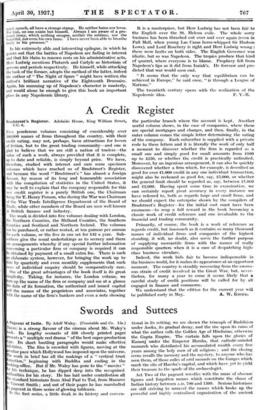Swords and Suttees
k. Its lengthy scenario of 528 closely printed pages resents a" multiple reel drama" of the best super-production YPe. Its short bustling paragraphs would make effective ub-titles. The film is crowded with figures, moving at the "liar pace which Hollywood has imposed upon the universe, e work in brief has all the makings of a "vertical trust
ation," beginning with Buddha and ending in the king-office. But if Mr. Waley has gone to the " movies " r his technique, he has dipped deep into the recognized uthorities for his story. He has laid under contribution all IC standard historians from Abul Faz1 to Tod, from Manucci Vincent Smith ; and out of their pages he has marshalled 's Pageant in three series of glowing tableaux.
In the first series, a little i-eak in its history and eonven- tional in its setting, we are shown the triumph of Buddhism under Asoka, its gradual decay, and the rise upon its ruins of what the author calls the Golden Age of Hinduism; otherwise the Gupta Empire. The curtain falls upon the glories of Kanauj under the Emperor Harsha, that catholic-minded monarch who distributed his accumulated wealth every five years among the holy men of all religions ; and the closing scene recalls the memory and the mystery, to anyone who has seen them, of those miles of arid mounds on the Ganges which mark the site of Harsha's capital, and which have yet to yield their treasure to the spade of the archaeologist.
Act Two of the pageant wrestles with the maze of obiscure. figures and forgotten names which constitute the chaos of Indian history between A.D. 700 and 1500. Serious historians are still striving to unravel the causes which broke up the powerful and highly centralized organization of the ancient Hindu Empires and rendered them so easy a prey to Moslem adventurers.. To our author the solution is simple : " the tragic love story," he writes, "of Prithvi Raj and Sangagota spelt the doom of the Hindu Empire in India, just as the fatal passion of Antony and Cleopatra brought ruin to the Egypt of the Pharaohs:' In many other passages the »totil is the same ; Mr. Waley's master-key to history is romance.
Ills central figures at this stage arc thus, as might be ex- pected, the Rajput chiefs who fought, and failed, to stem the Mahommedan invasions, and whose chivalry in battle was equalled only by the heroism of their women in defeat. At j aisalmir, for example, there pass before us the 24,000 Rajput ladies who flung themselves into the flames of a gigantic funeral pyre rather than be carried, when the city fell, as captives to the harems of Delhi. The tragedy is repeated in the beleaguered fortress of Chitor, where the entire female population, with their Queen bringing up the rear, courted the same terrible death, while their fathers and husbands sallied out against the army of Ala-tul-din and perished to a man. Chivalry and heroism alike, however, mere trodden in the dust by the new power of Islam ; and with this the curtain falls again.
It rises, in the third and longest act, on the halcyon period of the Great Moghuls, during the century and a half from Mbar to Auhusgzeb. Here there is plenty of action, on relatively familiar ground : Iinmayun placing on the Imperial throne for one day the humble water-carrier who had saved his life ; Akbar mounting the pulpit to preach his new universal religion ; Jehangir condemning his favourite son to be blinded, and then in an agony of remorse scouring Asia for a physician to restore his sight ; and many another equally vivid picture. All this makes excellent pageantry ; and the dun atmosphere of the Indian scene to-day throws. it into all the bolder relief.
Mr. Waley's book suggests a diversity of lessons ; but chief among them is the rhythmic movement in India's past towards and away from an artificial centralized political unity. Asoka, Harsha, Akbar, each at an interval of nine centuries from his predecessor, brought vast geographical areas under a uniform system of government. After each of them came disintegra- tion, rapid and complete ; and yet undismayed we are engaged in building up the same structure again. Our operations Jack the picturesqueness which characterized I heir fore- runners ; let us hope that they will offer the compensation of being more durable.











































 Previous page
Previous page